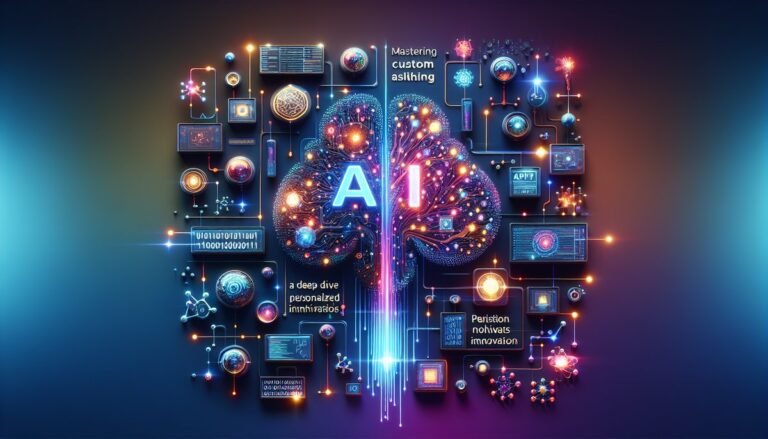In the shadowy corridors of financial crime, where deception and cunning rule, a new detective has emerged—Artificial Intelligence. While human investigators have long relied on intuition and experience, AI offers a different perspective, uncovering patterns and connections that often elude the human eye. It peers into the complex tapestry of transactions, sifting through mountains of data with unparalleled precision. But what exactly does AI see that we, with all our experience and expertise, do not?
Unveiling the Hidden Patterns
Financial crime is a sophisticated beast, thriving in the gaps of human oversight and exploiting the subtleties that often go unnoticed. Here, AI steps in as a powerful ally, equipped with the ability to detect faint signals amidst the noise. By processing vast amounts of information at lightning speed, AI can reveal hidden patterns and anomalies that might take humans years to identify. Imagine AI as a master weaver, unraveling the tangled threads of financial transactions to expose the intricate network of deceit. In doing so, it provides a fresh lens through which we can view the landscape of financial crime.
Beyond Human Intuition: Understanding AI’s Unique Perspective
Human intuition, while invaluable, can be limited by cognitive biases and emotional influences. AI, on the other hand, operates on a foundation of logic and data-driven analysis. It can process information without the constraints of fatigue or prejudice, making it an ideal tool for spotting irregularities in seemingly routine data. For instance, AI can analyze transaction volumes, times, and locations to pinpoint unusual activity that might suggest money laundering or fraud. In this way, AI complements human intuition, providing insights that can lead to breakthroughs in investigations.
The Role of Machine Learning in Crime Detection
At the heart of AI’s capabilities in financial crime detection lies Machine Learning. This technology enables AI to learn from historical data and improve its accuracy over time. By continually refining its models based on new information, AI becomes more adept at predicting and identifying suspicious behavior. It’s akin to a seasoned detective who, with each case, becomes more skilled at catching the criminal. This adaptive learning process allows AI to stay ahead of evolving criminal tactics, offering a dynamic defense against financial misconduct.
Ethical Considerations and Challenges
However, the deployment of AI in financial crime detection is not without its challenges and ethical considerations. The reliance on data-driven models raises questions about privacy and surveillance, as well as the potential for bias in AI algorithms. Ensuring transparency and accountability in AI systems is crucial to maintain trust and integrity. Moreover, the human element cannot be entirely removed from the equation. Collaborating with AI requires a careful balance, where human judgment and ethical standards guide the implementation of AI solutions.
In the fight against financial crime, AI stands as a formidable ally, offering insights that reach beyond human capabilities. By illuminating the unseen patterns and connections, AI not only aids in solving existing cases but also fortifies our defenses against future threats. As we continue to explore the depths of AI’s potential, we must also navigate the ethical landscape, ensuring that this powerful tool is used responsibly and effectively. In doing so, we unlock a new frontier in the battle against financial crime, one where human ingenuity and AI innovation work hand in hand.
Decoding the Complex Patterns of Financial Crime Through AI
In the labyrinthine world of financial crime, Artificial Intelligence emerges as an astute detective, uncovering intricate patterns that often elude human scrutiny. The sheer volume and complexity of financial data make traditional methods of detection cumbersome and sometimes ineffective. AI, with its ability to process and analyze large datasets rapidly, excels in identifying anomalies, subtle patterns, and connections that signal fraudulent activity.
By leveraging machine learning algorithms, AI systems can learn from historical data and continuously update their understanding of what constitutes suspicious behavior. This dynamic learning process enables AI to adapt to the ever-evolving tactics of financial criminals, offering a level of vigilance that human analysts simply cannot maintain at scale.
Unveiling Hidden Anomalies and Patterns
Financial crime often involves subtle anomalies that are difficult to detect through manual analysis. AI technologies, particularly those using machine learning, can sift through vast amounts of transaction data to identify these anomalies. For instance, AI can spot unusual patterns in transaction sequences, such as money laundering practices where funds are moved through a series of transactions to obscure their origin.
Consider a hypothetical scenario where a series of small but frequent transactions occur in different locations, all linked to a single entity. While these may initially appear innocuous, AI can correlate these transactions with known patterns of illicit activity, flagging them for further investigation. This ability to connect the dots across disparate datasets is where AI’s strength truly shines.
Empowering Predictive Analytics in Fraud Prevention
Beyond identifying existing fraudulent activities, AI is instrumental in predictive analytics, helping financial institutions anticipate and mitigate risks before they manifest. By analyzing historical data, AI can build predictive models that forecast potential fraudulent activities. This proactive approach allows organizations to implement preventative measures, effectively reducing the risk of financial crime.
For example, AI can predict the likelihood of credit card fraud by analyzing past transaction behaviors and identifying deviations from a user’s typical spending patterns. This predictive capability not only enhances security but also reduces the financial and reputational damage associated with such crimes.
Enhancing Human Decision-Making with AI Insights
While AI offers remarkable capabilities in detecting financial crime, its true potential is realized when combined with human judgment. AI tools provide valuable insights that empower human analysts to make more informed decisions. By presenting data-driven evidence of potential risks, AI enables analysts to focus on high-priority cases, thereby optimizing resource allocation.
Take the example of a financial analyst reviewing transactions flagged by AI. Armed with detailed reports and insights generated by AI systems, the analyst can make quicker and more accurate assessments regarding the legitimacy of these transactions. This collaboration between AI and human intelligence creates a formidable barrier against financial criminals.
The Ethical Considerations of AI in Financial Surveillance
As AI becomes more prevalent in financial crime detection, ethical considerations must be addressed. The use of AI for surveillance raises concerns about privacy and the potential for bias in algorithmic decision-making. Ensuring transparency in AI processes and maintaining strict data privacy standards are crucial to building trust among stakeholders.
Financial institutions must implement robust governance frameworks to oversee AI deployments, ensuring that these systems operate within ethical boundaries. Moreover, continuous monitoring and auditing of AI systems can help identify and rectify any biases, ensuring fair and equitable treatment of all parties involved.
Looking Ahead: The Future of AI in Financial Crime Detection
The future of AI in financial crime detection is promising, with advancements in deep learning and natural language processing poised to further enhance the capabilities of AI systems. These technologies will enable even more sophisticated pattern recognition and analysis, further reducing the gap between criminal tactics and detection capabilities.
As AI continues to evolve, it will play an increasingly pivotal role in safeguarding the financial sector from illicit activities. By staying ahead of technological advancements and maintaining a commitment to ethical practices, financial institutions can harness the full potential of AI to protect their assets and maintain the trust of their customers.
Unveiling Hidden Patterns: The AI Advantage in Financial Crime
The integration of Artificial Intelligence into financial crime detection is reshaping our understanding of security in unprecedented ways. AI’s ability to process vast amounts of data at lightning speed allows it to identify patterns and anomalies that the human eye might miss. While traditional methods rely on predefined rules and historical data, AI adapts and evolves, offering a dynamic approach to threat detection. As we move forward, embracing AI’s potential can lead to more secure financial landscapes by foreseeing fraudulent activities before they manifest. The future holds promise not just in refining these technologies but also in expanding their applications, underscoring the importance of looking beyond conventional tech paradigms for innovative opportunities.
What unique capabilities does AI bring to financial crime detection?
AI offers the ability to analyze large datasets rapidly, identifying complex patterns and anomalies that are often invisible to human analysts. This allows for the detection of fraudulent activities with a higher degree of accuracy and speed, significantly enhancing the efficiency of financial crime prevention.
How does AI improve upon traditional methods of financial crime detection?
Unlike traditional methods that rely on static rules, AI utilizes machine learning algorithms to continuously learn and adapt to new threats. This dynamic approach enables the detection of novel and sophisticated fraud tactics that might bypass conventional systems.
What challenges does AI face in the realm of financial crime prevention?
Some challenges include data privacy concerns, the need for high-quality data inputs, and the potential for adversarial attacks where fraudsters attempt to deceive AI systems. Addressing these issues is crucial for the successful integration of AI in financial security.
What is the future of AI in combating financial crime?
The future of AI in financial crime prevention lies in developing more advanced algorithms that are capable of real-time learning and adaptation. Additionally, collaboration between AI developers, financial institutions, and regulatory bodies will be essential in creating robust, secure, and ethical AI systems.
Dive Deeper into AI & Tech
- How To Use Janitor Ai Roleplay Guide
- Android Vs Ipad Car Tablets
- Car Stereo With Apple Carplay
- Ai 171 Uk Convocations
- Nanoparticles Ai Disease
- Best Wireless Carplay Dongle
- Install Apple Carplay Older Car
- Kling Ai Review Product Photos 2025






